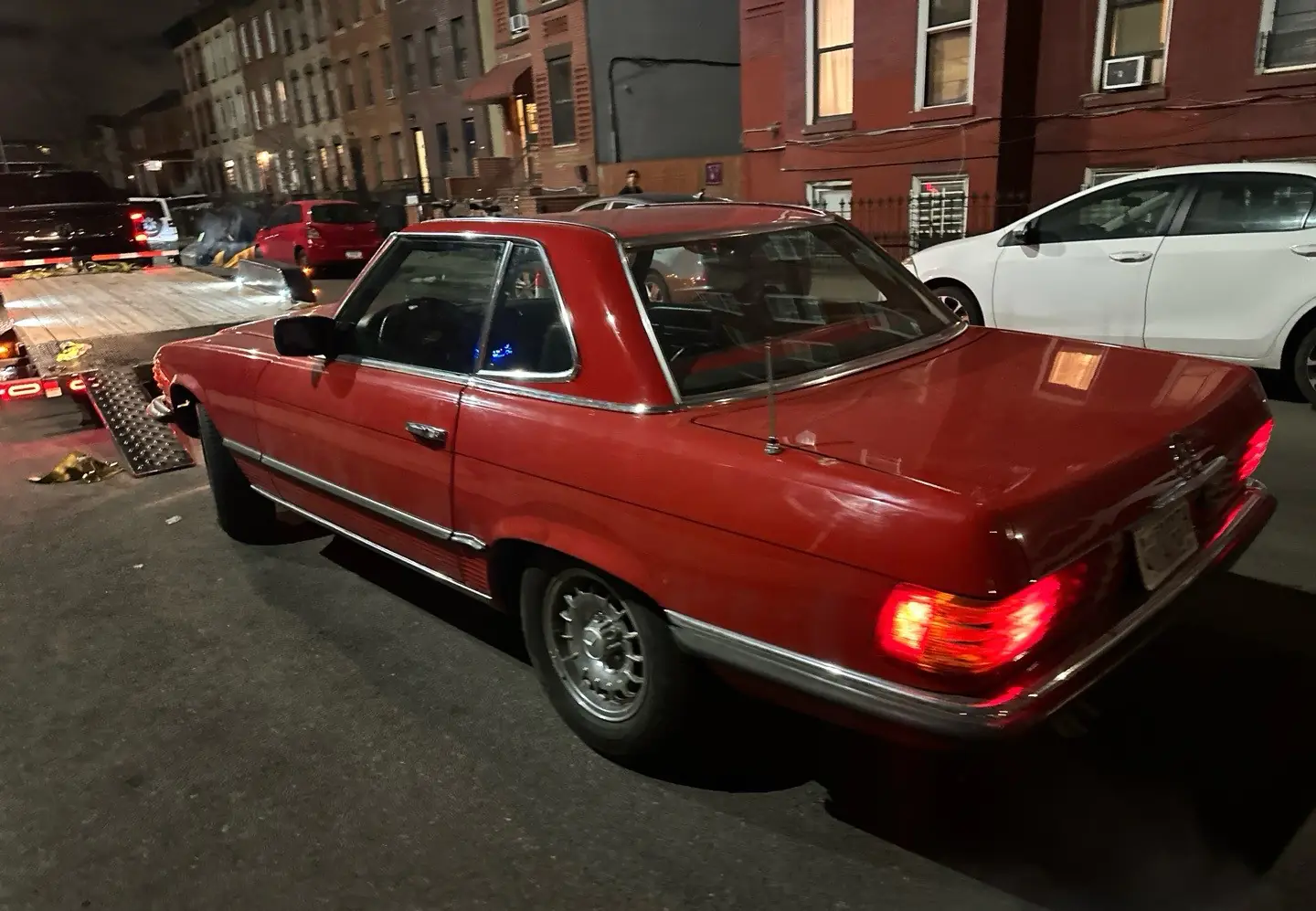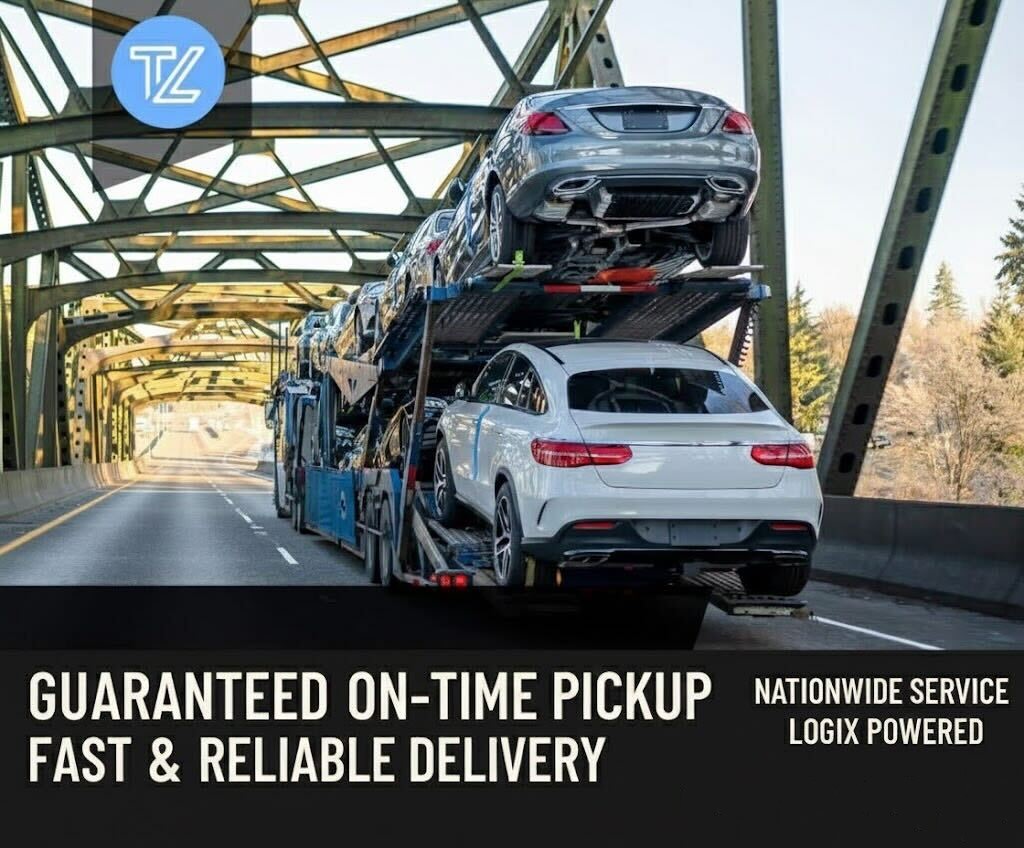The Complete Detroit Auto Show 2026 Transport and Attendance Guide
The Detroit Auto Show returns to Huntington Place January 14-25, 2026. Most people focus on the shiny new vehicles and concept cars on display. Few stop to think about how those vehicles actually get there.
Moving 500 vehicles from manufacturers across the country to one convention center creates a real puzzle. The answer involves special carriers and tight deadlines. Understanding this process reveals why vehicle transport prices jump across Metro Detroit during the show.
Behind the Curtain: How 41 Car Brands Actually Get Their Vehicles to the Detroit Auto Show
Getting display vehicles to an auto show is different from shipping your personal car. These vehicles need to arrive in perfect condition. A single scratch or chip means the manufacturer loses its chance to make that critical first impression.
Most manufacturers start planning transport six to eight weeks before the show opens. They work with special carriers who handle high-value vehicles daily. The timeline matters because these vehicles must arrive before Media Days on January 14-15.
The Enclosed Transport Standard
Open carriers won’t cut it for auto show vehicles. Manufacturers use enclosed transport exclusively for display vehicles. Hard-sided enclosed trailers protect against weather and road debris. They also provide security during overnight stops.
These enclosed carriers typically haul two to seven vehicles per load. The reduced capacity compared to standard open carriers drives up the cost. A standard open carrier might haul nine vehicles. An enclosed trailer carries fewer vehicles but offers better protection.
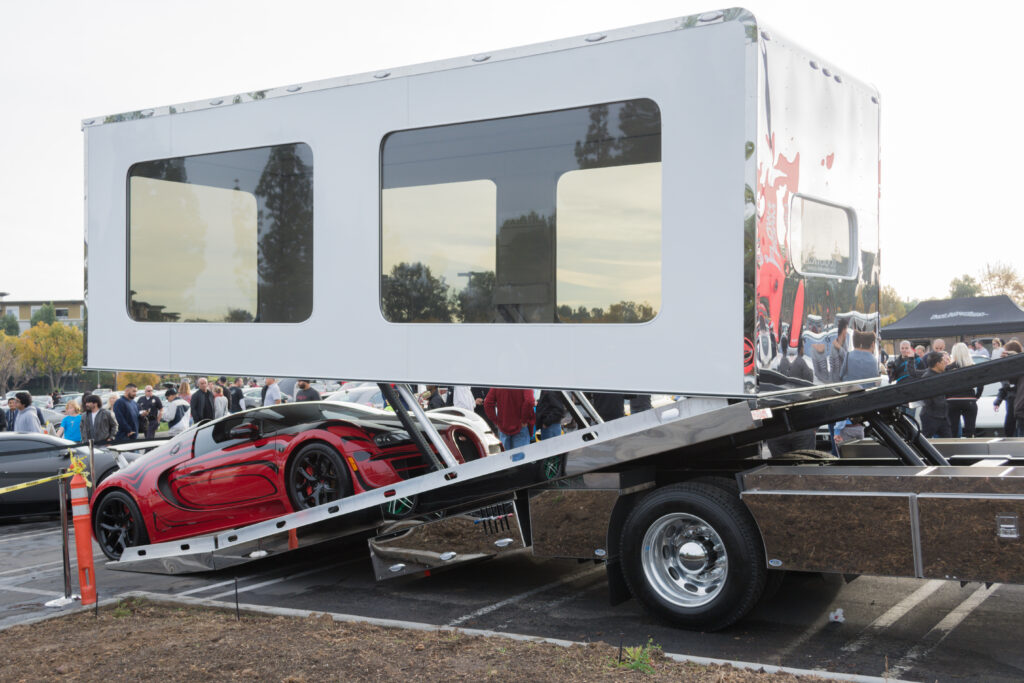
The equipment itself costs more to run. Enclosed trailers run between $15,000 to $25,000 more than open ones in equipment costs alone. That expense gets passed down through pricing.
Loading Methods for Low-Clearance Vehicles
Many concept cars and sports cars sit extremely low to the ground. A 2022 Lamborghini Huracan has just 3.5 inches of ground clearance. Loading these vehicles requires special equipment.
Carriers use hydraulic tilt-bed rollbacks or liftgates for low-clearance vehicles. Some use Go-Jaks dollies that slide under the wheels. These methods prevent undercarriage damage during loading.
The loading process for one exotic vehicle can take 60 to 90 minutes. Multiply that by hundreds of vehicles arriving within a tight window. The team coordinates arrival times down to specific hours.
Insurance Requirements
Standard cargo insurance covers $100,000 to $500,000 per load. Auto show vehicles often exceed these limits significantly. A single concept car might be worth several million dollars.
Manufacturers require carriers to carry $2 million to $5 million in cargo coverage. Some exotic vehicles demand even higher limits. The premium pricing for enclosed exotic transport reflects these insurance costs.
Federal rules require all carriers to maintain at least $1 million in public liability coverage. This is the accepted industry standard for vehicles containing fuel. Higher coverage protects everyone involved in the transport chain.
Dealer-Supplied Vehicles
Not every vehicle at the show comes directly from manufacturers. Local dealerships supply many of the display vehicles. This is especially true for brands like BMW and Honda that don’t exhibit directly.
Metro Detroit dealerships work with manufacturers to provide showroom-ready vehicles. These cars often arrive via local transport within Michigan. The distances are shorter but the care requirements remain identical.
Dealerships benefit from the exposure. Attendees who see a specific model at the show often visit that dealership afterward. This creates a relationship that works for both manufacturers and local dealers.
Timing and Coordination
Media Days happen January 14-15. Industry professionals get exclusive access before the public show opens. Vehicles must be in place and detailed by January 13 at the latest.
This creates a compressed arrival window. Carriers converge on Detroit during a 48 to 72-hour period. Loading docks at Huntington Place run around the clock during setup.
Weather adds another variable. January in Detroit means potential snow and ice. Carriers build buffer time into schedules to account for weather delays. A snowstorm can push arrival times back by 12 to 24 hours.
See also: How to Safely Transport Your Classic Car to the Next Auto Show
Detroit Auto Show Dealer Preview: Which 2026 Models Will Cost the Most to Transport
Vehicle weight and dimensions directly impact transport costs. Understanding these factors helps dealerships forecast total purchase costs. The 2026 model year brings several vehicles that present transport challenges.
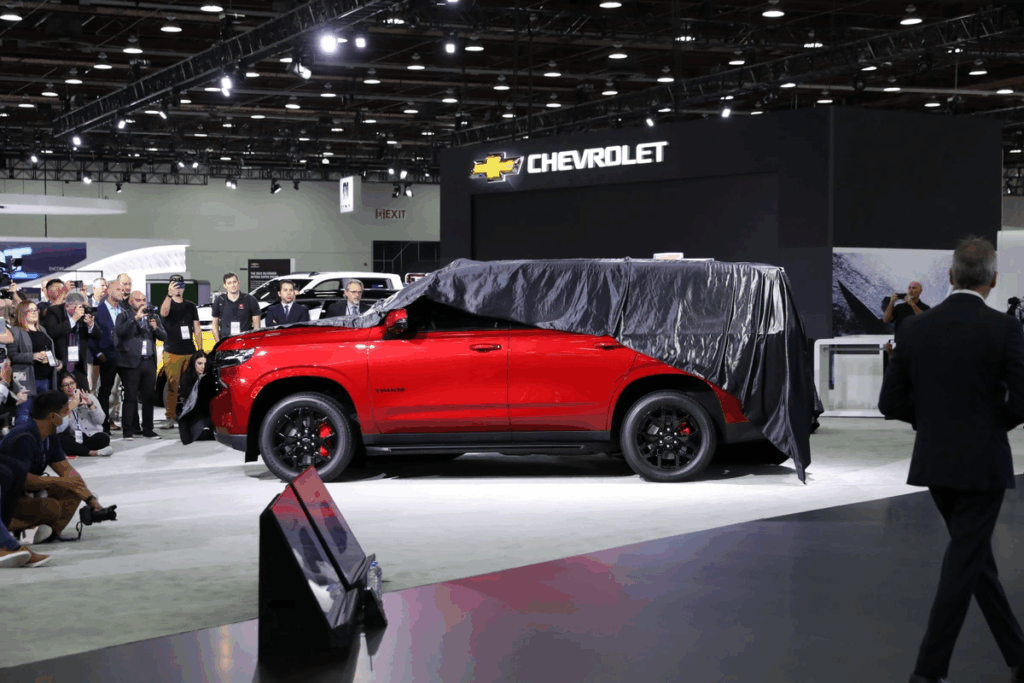
How Weight Affects Pricing
Federal rules limit gross vehicle weight to 80,000 pounds. An empty car hauler weighs 30,000 to 35,000 pounds. This leaves 45,000 to 50,000 pounds of cargo capacity.
Average sedans weigh 4,000 to 4,500 pounds. Full-size pickups run 5,000 to 6,500 pounds. Heavy vehicles like lifted trucks can reach 6,000 to 8,000 pounds.
A carrier can fit seven to ten vehicles per load depending on weight distribution. One heavy vehicle reduces total capacity. Fewer vehicles per load means higher per-vehicle costs.
Large SUVs and Electric Vehicles
Three-row SUVs and full-size trucks take up significant space. They also weigh more than standard vehicles. This combination makes them expensive to transport.
Electric vehicles add another dimension. Many EVs weigh 500 to 1,000 pounds more than comparable gas vehicles. The battery pack accounts for this extra weight.
A Tesla Model X weighs about 5,500 pounds. A comparable gas SUV might weigh 4,800 pounds. That 700-pound difference matters when loading a carrier to maximum capacity.
Low-Clearance Performance Vehicles
Sports cars and performance vehicles often require enclosed transport. Ground clearance under four inches makes standard ramp loading risky. The special loading equipment adds to costs.
Enclosed exotic transport costs roughly 180% to 400% more per mile than standard open transport. A Corvette Z06 or Porsche 911 falls into this category. Dealers ordering these vehicles need to budget accordingly.
The premium reflects real equipment costs and reduced capacity. A two-car enclosed trailer provides maximum protection. It also means the carrier hauls fewer vehicles per trip.
Size Restrictions for Oversized Vehicles
Some trucks and SUVs exceed standard trailer dimensions. Vehicles over 80 inches wide or 14 feet tall require special permits. This adds complexity and cost to transport.
Hummer EVs and certain lifted trucks fall into this category. The permit process varies by state. Some routes become unavailable because of bridge or tunnel clearances.
Carriers charge premium rates for oversized loads. The additional paperwork and route restrictions justify higher pricing. Dealers should expect 25% to 40% increases for these vehicles.
Distance and Regional Factors
Detroit sits in the Midwest. Vehicles arriving from the West Coast travel 2,000 to 2,400 miles. East Coast shipments cover 600 to 800 miles.
Standard transport averages $0.75 to $1.20 per mile for open carriers. Enclosed transport runs $1.30 to $2.10 per mile. These rates vary based on route popularity and demand.
A vehicle shipped from Los Angeles to Detroit would cost approximately $1,800 to $2,500 via enclosed transport. The same vehicle from New York might run $900 to $1,400.
Tempus Logix provides nationwide auto transport in any direction, including enclosed and oversized loads. You can get an accurate shipping estimate before you commit using our AI-based calculator.
To support Detroit Auto Show attendees who purchase vehicles during this year’s event, Tempus Logix is announcing an exclusive 10% discount on vehicle transportation services, available only to attendees
Detroit Auto Show 2026: What Attendees Wish They’d Known About Parking, Tickets, and Timing
The public show runs January 17-25. Over 250,000 visitors are expected during this nine-day period. Planning ahead makes the experience smoother.
Parking
Downtown Detroit fills up fast during the auto show. Huntington Place doesn’t have dedicated parking for all attendees. Most people use nearby lots or garages.
Rates typically increase during major events. Expect to pay $20 to $40 for garage parking near the venue. Arriving early gives you better parking options.
The Detroit People Mover offers an alternative. This elevated rail system stops at multiple downtown locations. A ride costs just $0.75 and connects to Huntington Place.
Ticket Pricing and Advance Purchase
Public show tickets run about $20 for adults. Children under 12 typically get discounted rates. Group sales of 30 or more receive reduced pricing at $18 per ticket.
Buying tickets online before the show saves time at the entrance. Lines form during peak hours on weekends. Weekday mornings see lighter crowds.
The show opens at 10 AM most days. It closes at 8 PM except Sunday January 25 when it ends at 7 PM. Last entry happens 15 minutes before closing.
Best Days to Visit
Weekends draw the largest crowds. Saturday January 17 and both Sundays will be packed. Families with children often choose these days.
Weekday visits offer a more relaxed experience. Tuesday January 20 is Racing Day with special programming. This attracts motorsports fans but remains manageable.
The final weekend sees attendance drop slightly. People who waited until the end often find shorter lines and easier parking.
What to Bring
Comfortable shoes are essential. Huntington Place spans over one million square feet of exhibit space. You’ll walk several miles viewing all the displays.
Bring a portable phone charger. Most people take photos and use social media throughout their visit. Battery life drains quickly with constant use.
The venue allows small bags and backpacks. Security screening happens at entrances. Plan a few extra minutes for this process during busy periods.
Why ‘Expedited Shipping’ Is the Most Requested Service After the Detroit Charity Preview
The Charity Preview happens Friday January 16 from 5 PM to 9 PM. This black-tie fundraiser has raised over $125 million for children’s charities since 1976. Robin Thicke headlines the 2026 event.
The Gallery and High-End Sales
The Gallery showcases ultra-luxury vehicles on January 13. Over 50 exotic and luxury vehicles appear in this exclusive section. Brands include Aston Martin, Bentley, Ferrari, Lamborghini, Maserati, and Rolls-Royce.
Some of these vehicles sell during the Charity Preview. Buyers want immediate possession. The vehicles must leave Huntington Place to make room for public show operations.
Why Speed Matters
Auto show operations run on tight schedules. The public show opens Saturday January 17 at 10 AM. Setup crews need access to floor space by early Saturday morning.
Sold vehicles can’t remain on the show floor. They must be removed and transported to their new owners quickly. This creates urgent demand for expedited transport services.
Expedited Transport Costs
Standard auto transport takes seven to ten days coast-to-coast. Regional shipments complete in two to five days. Expedited service cuts these timeframes significantly.
Guaranteed pickup within 24 hours costs 30% to 50% more than standard service. Rush delivery to specific dates adds another premium. Total costs can double for true expedited service.
A luxury vehicle sold at the Charity Preview might need delivery to California within three days. The buyer paid $150,000 for the car. Paying an extra $1,500 for expedited enclosed transport seems reasonable.
Carrier Availability
Fewer carriers offer expedited service. Most run on regular routes with multiple pickups and deliveries. Dedicating a truck to one vehicle costs the carrier potential revenue.
The carrier must have equipment available immediately. During peak seasons this becomes difficult. Detroit in mid-January coincides with snowbird season.
The Luxury Positioning
Expedited service positions itself as a luxury necessity. High-net-worth buyers expect exceptional service. Waiting two weeks for vehicle delivery doesn’t align with their expectations.
Transport companies market expedited service as white-glove treatment. The messaging emphasizes speed and exclusivity. This justifies premium pricing.
The Detroit Squeeze: Why 250,000 Visitors Are Spiking Car Shipping Rates
The auto show creates unique market dynamics. Understanding these factors helps explain pricing fluctuations around the event.
The Localized Demand Surge
Huntington Place expects 250,000 visitors over nine days. Many fly into Detroit specifically for the show. Some decide to purchase vehicles from Metro Detroit dealerships during their visit.
Local dealerships run “Auto Show Specials” during this period. These promotions drive sales. Buyers often live out of state and need their new vehicles shipped home.
Pickup requests in the Detroit metro area spike during the two-week period around the show. Carriers face more demand than available capacity.
The Uber Effect
Car carriers work on supply and demand like any marketplace. When everyone wants service at once, prices increase. Brokers bid higher to secure carriers for their customers.
A standard Michigan to Florida shipment might cost $800 outside auto show season. During the show that same route could jump to $950 to $1,000. That represents a 15% to 20% increase.
The spike affects pickups within 50 miles of Detroit most severely. Shipments starting in outlying areas see smaller increases. The concentration of demand drives the premium.
Carrier Route Preferences
Carriers prefer routes where they can secure loads in both directions. Deadhead miles cost money without generating revenue. A carrier hauling vehicles from Florida to Detroit wants a return load.
During the auto show, return loads from Detroit become easier to find. This should theoretically reduce rates. However, the sheer volume of requests allows carriers to maintain higher pricing.
The Snowbird Conflict
The Detroit Auto Show happens in January. This timing creates a perfect storm. January is peak snowbird season for vehicle transport.
Snowbirds are retirees who spend winters in warm climates. They ship vehicles from Midwest states like Michigan to Florida and Arizona. This seasonal migration happens October through January.
Carriers make excellent profits on snowbird routes. Michigan to Florida is one of the busiest corridors. Detroit to Phoenix follows similar patterns.
Competition for Carrier Space
A buyer at the auto show ordering a new vehicle to be shipped to Florida faces competition. Thousands of snowbirds booked transport months earlier. They have priority with carriers.
This drives prices up by $200 to $400 above yearly averages. A typical Michigan to Florida shipment averages $750 to $900. During snowbird season it jumps to $950 to $1,300.
Add auto show demand on top of snowbird season. The combination creates pricing pressure. Buyers shipping to southern states during late January pay premium rates.
Booking Timeline Matters
Most transport companies recommend booking two to four weeks ahead. During peak seasons they suggest six to eight weeks advance notice. This secures better rates and carrier availability.
Someone buying a car at the auto show on January 20 wants immediate pickup. Last-minute bookings always cost more. The combination of short notice and peak season compounds expenses.
Smart buyers plan ahead. If you know you’ll purchase at the auto show, book transport before arriving. Provide the dealership address as the pickup location. Adjust the booking once you finalize the purchase.
Industry Perspective
Transport brokers understand these seasonal patterns. They adjust customer expectations accordingly. Honesty about pricing helps maintain trust.
A broker should explain why rates are higher during specific periods. Weather factors also impact January pricing. Snow and ice create delays. Carriers build buffer time into schedules.
The Federal Motor Carrier Safety Administration regulates hours of service. Drivers can work 11 hours maximum per day within a 14-hour window. They must take a 30-minute break after eight hours of driving.
These rules mean realistic transit times are seven to ten days coast-to-coast. Coast-to-coast averages 2,800 miles. At 450 miles per day, that takes six to seven days of driving time.
Planning Your Auto Show Transport
Knowing more about the transportation sector gives you better perspective for setting proper expectations. Here are some helpful tips for anyone moving a vehicle during the Detroit Auto Show.
Book as early as you can. Two to four weeks notice is worth the discount. Six to eight weeks is best during January.
Be flexible about pickup times. Day-of pickup is expensive. A two-day or three-day window is cheaper. Carriers value flexibility and reward it with good rates.
Get your car ready. Take out your personal stuff. Clean your car and photograph it. This helps you in case your car gets damaged during shipping.
Understand your coverage. Request proof of coverage from the companies. Compare the coverage amounts to your vehicle’s worth. Get extra coverage for expensive vehicles.
Share clear details about any special requirements. Low clearance requires special transport equipment. Non-running cars need carriers with winch capabilities. This helps avoid delays in car pickup.
Track the shipment. Reliable carriers usually offer this. GPS technology makes it a reality now. You always know where your vehicle is.
Inspect at delivery. Carefully examine your vehicle before signing the Bill of Lading. Document any damage. Take photographs if it looks different.
“Each Detroit Auto Show is a manifestation of America’s passion for autos,” explains Wright Dunbar Jr., a Detroit lawyer with a passion for alternative modes of transportation. “But let me tell you: a great deal of work goes into organizing such a show,” he adds.
Whether you’re a dealer estimating purchase costs or a buyer arranging home delivery of your new vehicle, it helps to know. The car show presents its own set of pricing challenges.
Detroit is still Motor City. The car show proves it every January. The cars get delivered safely because experts handle their transport. It’s important to acknowledge their expertise.
How We Successfully Shipped an Ambulance Truck Cross-Country
Tempus Logix recently transported a 2015 International Terra Star ambulance from Miami, Florida to Chino, California. The 14,000-pound emergency vehicle covered 2,750 miles and required specialized equipment. Standard car haulers can’t handle vehicles in this weight class.
Understanding Specialized Ambulance Truck Transport Requirements
Ambulances require careful planning before transport begins. The 14,000-pound weight puts this vehicle well above typical passenger cars that weigh 3,500 to 4,500 pounds.
Tempus Logix verifies all dimensions before confirming the final price. Height, width, and length measurements determine whether a vehicle qualifies as oversized. Federal regulations set maximum dimensions at 8 feet 6 inches wide and 13 feet 6 inches tall.
The Terra Star needed dimension verification to confirm it stayed within legal limits. Anything beyond standard measurements requires special permits from each state along the route.
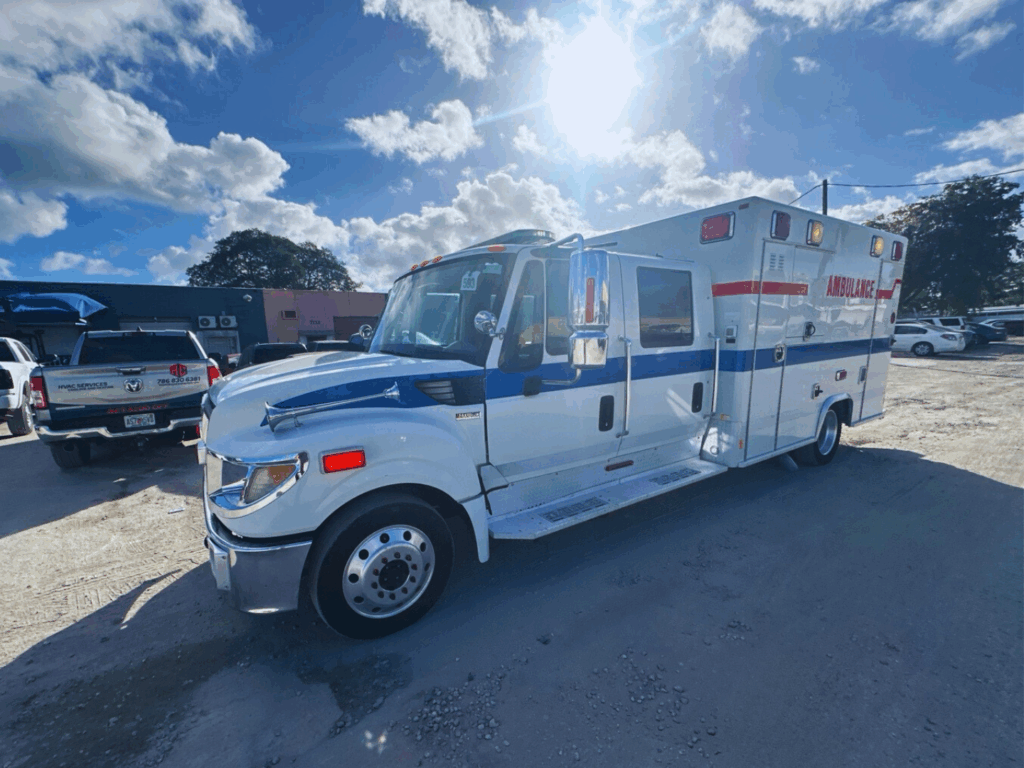
Additional Costs: Permits, Escorts, and Specialized Equipment Fees
Heavy vehicles require permits even when dimensions stay within legal limits. Weight permits ensure transport stays compliant with DOT regulations. Each state charges its own permit fees.
The Miami to Chino trip crossed Arizona, New Mexico, and Texas. Each state required separate permits for the heavy load. Permit costs typically range from $100 to $500 per state.
Escort vehicles weren’t needed for this ambulance because it fell within legal dimensions. The combined weight stayed under the 80,000-pound federal maximum.
14,000 lbs Weight Class: Equipment and Trailer Requirements
Standard car haulers can’t safely transport 14,000-pound vehicles. Three main trailer types handle this weight category.
RGN trailers work best for heavy vehicles between 10,000 and 40,000 pounds. Step deck trailers offer a lowered deck design. Lowboy trailers provide the lowest deck height.
RGN trailers feature a detachable front section that lowers to ground level. This makes loading much easier. The front section reattaches after the vehicle drives onto the deck.
Why RGN Trailers Are Ideal for 14,000 lb Ambulance Trucks
The Terra Star loaded onto an RGN trailer for good reasons. These trailers handle weight distribution better than flatbeds. The removable gooseneck design allows the entire front to disconnect.
Tall vehicles must maintain legal height when loaded. Adding the deck height to the vehicle height determines total transport height. RGN trailers sit lower than standard flatbeds and kept this ambulance under the 13 feet 6 inches limit.
The RGN design also protects the ambulance during loading. The deck lowers almost to ground level. Vehicles drive straight on without steep ramp angles that could cause damage.
Estimated Transit Times for 2,750-Mile Ambulance Delivery
The Miami to Chino route covers roughly 2,750 miles. Federal Hours of Service regulations limit drivers to 11 hours of driving per day. At 60 miles per hour average speed, drivers cover 500 to 600 miles daily.
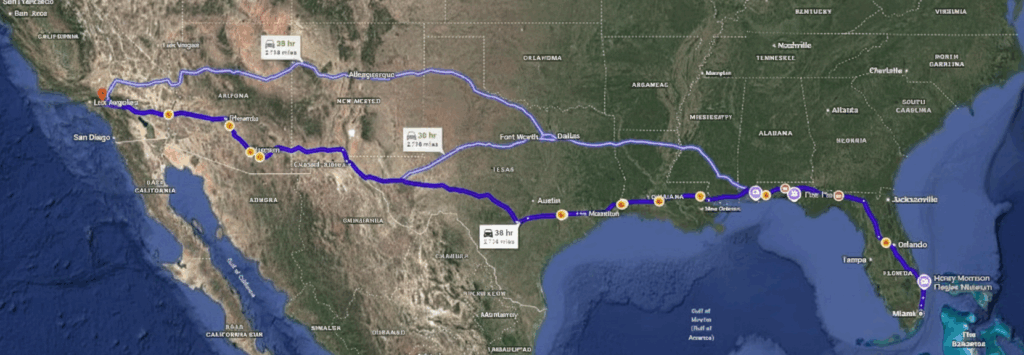
The 2,750-mile journey takes approximately 5 to 6 days of driving time. This accounts for rest breaks and fuel stops. Weather and traffic add variability to any cross-country transport.
This ambulance delivery took 7 days from pickup to final delivery. The driver followed all DOT regulations and maintained proper rest periods. The vehicle arrived in Chino without damage.
Tempus Logix handles heavy vehicle transport with attention to detail. Every dimension gets verified and every permit gets secured before the truck leaves. No shortcuts happen when 14,000 pounds of emergency equipment travels across the country.
Shipping Summary
Vehicle: 2015 International Terrastar Ambulance
Route: Miami, FL to Chino, CA (2,700 miles)
Miami, FL → I-10 W → Houston, TX → San Antonio, TX → El Paso, TX → Tucson, AZ → Phoenix, AZ → Blythe, CA → I-10 W → Ontario/Chino, CA
Service: RGN Specialized Trailer
Total Price: $5,500 ($2.03 per mile)
Enroute Transport Permits
| State | Permit Required? | Key Notes | Typical Legal Dimensions (before permit) |
| Florida (FL) | Yes | Permits from Florida DOT; dimensions >8’6″W/13’6″H or weight over limits. Trip permits valid ~10 days, blanket up to 12 months. (Florida Highway Safety) | ~8’6″ W, 13’6″ H, 75’ L |
| Alabama (AL) | Yes | Permit required for oversize/overweight. Contact AL DOT. (FHWA Operations) | ~8’6″ W, 13’6″ H |
| Mississippi (MS) | Yes | Must obtain oversize/overweight permit. (Keller Permits) | ~8’6″ W, 13’6″ H |
| Louisiana (LA) | Yes | Permits required; often with police/pilot cars if extremely oversize. (Keller Permits) | ~8’6″ W, 14′ H |
| Texas (TX) | Yes | Permit from TxDMV; Texas generally flexible for oversize/overweight. (The Carrier Info) | ~8’6″ W, 14′ H |
| New Mexico (NM) | Yes | Oversize/overweight permits required. (Keller Permits) | ~8’6″ W, 14″ H |
| Arizona (AZ) | Yes | Must obtain permit for oversize/overweight moves. (Keller Permits) | ~8’6″ W, 14′ H |
| California (CA) | Yes | Caltrans permits required for oversize/overweight; strict routing and lead times possible. (The Carrier Info) | ~8’6″ W, 14′ H |
2026 Detroit Auto Show: Full Event Schedule
The Detroit Auto Show is making a big comeback in 2026. The auto show has been bouncing around on different dates over the past few years due to the pandemic. However, it appears to be back to its regular schedule in January. This is just right for people who are auto enthusiasts.
The dates for the Detroit Auto Show in the year 2026 are scheduled to take place between the 14th and the 25th of January at the Huntington Place in Detroit. The attendance last year had been recorded at 275,000 visitors, and the economic impact was estimated at $370 million to the city. It is more than just numbers. It is evident in the hotel occupancy and the restaurants.
The 2026 edition looks even bigger. For 2026, there are 41 brands participating, an increase from 34 brands seen in 2025. The list of participants includes key players such as Ford, GM, Stellantis, and Toyota. The fact that they registered first is an indication that the Motor City still counts in the global automotive industry.
Here’s what makes it more than just clicking through some car sites. You can get in these cars. You can talk to the people who built them. There are four interactive track experiences where you can ride along in the cars and be shown what they are capable of by some pros.
See also: The Complete Detroit Auto Show Transport and Attendance Guide
NAIAS 2026 Dates, Venue, and Schedule Information
I’d like to walk you through the timeline because it does get a bit confusing. The show is not one thing that is unrolling for 12 days consecutively.
Gallery: This kicks off on January 13 between 6-9 PM. This is where there will be over 50 ultra-luxury vehicles from Aston Martin, Bentley, Ferrari, Lamborghini, Maserati, and Rolls-Royce, to name a few. This costs $250 per person or a pair for $400. This supports Forgotten Harvest to feed families in Southeast Michigan.
Industry Days will take place January 14-15 between 9 AM and 7 PM. This event is for media and industry representatives. During these two days, there would be the Mobility Global Forum with talks and panels on what is to come for the auto industry. The speaker for this occasion would be Pete Buttigieg, former Secretary of Transportation of the U.S.
Charity Preview will be held on January 16 from 5-9 PM. This is the black-tie gala that has raised more than $125 million for children’s charities for over 30 years, dating back to 1976. Robin Thicke will provide the evening’s entertainment. Jalen Rose is Master of Ceremonies.
Public Show days are from Jan 17-25. The event will be open 10 am to 8 pm, except on Sunday, Jan 25. Its closing time will be 7 pm. Tickets will be priced at $20 for adults, $10 for children aged 7-12. Children aged 6 years and under will be free.
Here’s what you should bear in mind if you plan on attending. There will be no admission past 7:45 PM on most days, and 6:45 PM on the last Sunday of the event. They are very strict about this, so don’t show up at 7:50 hoping to get in.
Helpful Links:
Detroit Auto Show 2026 Schedule
Detroit Auto Show 2026 Tickets
Detroit Auto Show 2026 New Updates – Top Announcements & Highlights
There were 34 brands and almost 500 cars at last year’s event. The 41 brands this year imply even more diversity in offerings.
| 1. Alfa Romeo | 15. Subaru | 29. Lotus |
| 2. Ariel | 16. Toyota | 30. Lucid |
| 3. Aston Martin | 17. Volkswagen | 31. Maserati |
| 4. Audi | 18. Bentley | 32. McLaren |
| 5. Buick | 19. Cadillac | 33. Mercedes |
| 6. Chevrolet | 20. Chrysler | 34. Mini |
| 7. Dodge | 21. Ferrari | 35. Morgan |
| 8. Fiat | 22. Ford | 36. Nissan |
| 9. GMC | 23. Honda | 37. Pagani |
| 10. Hyundai | 24. INEOS | 38. Pininfarina |
| 11. Jaguar | 25. Jeep | 39. Polestar |
| 12. Kia | 26. Koenigsegg | 40. Porsche |
| 13. Lamborghini | 27. Land Rover | 41. Ram |
| 14. Lincoln | 28. Rolls-Royce |
There will be electric cars everywhere. The Detroit Auto Show will again offer the indoor EV Experience with an acceleration lane in excess of 300 feet. The auto goes through a serpentine route. The passenger sits in the auto alongside an experienced driver who helps one go through all the routes. It is one thing to read about the power of torque in an electric motor. It is quite another experience.
The preliminary nominees for the North American Car, Truck, and Utility Vehicle of the Year Awards are set to be announced during the event. The car nominations include Dodge Charger, Honda Prelude, and Nissan Sentra. Truck nominees consist of Ford Maverick Lobo and Ram models. Utility nominees include Hyundai Palisade, Lucid Gravity, and Nissan Leaf.
See Also: Winners of 2025 Detroit Auto Show“
Racing Day” comes back this year as part of a partnership with the “Chevrolet Detroit Grand Prix.” You’ll get a chance to see IndyCar racing, car demos, and hands-on activities. Watch professional car racing, where a car’s performance will be tested on a tight track if you’ve never attended a similar event before. But one cool newcomer in the world of model autos in the year 2026 is the U.S. premiere of the Levegh model collection. The Parisian company produces highly detailed models scaled at 1/8 of actual size. The detail on these models is nothing short of astonishing.
However, the show is more than just new cars. “Modded Detroit” will feature custom car builds. “Drive the Beat” will feature live performances on the exhibit floor. These add a bit of flair to the event, turning the trade show into a celebration.

2026 Auto Show Highlights: What to Expect
Walking into Huntington Place during auto show week feels electric. The energy is different from any other automotive event.
Electric Vehicle Launches Expected at Detroit Auto Show 2026
The shift to electric is happening fast. Given the way the industry is going, attendees can anticipate a lot of electric vehicles and hybrids on the floor.
Ford will likely showcase updates to the F-150 Lightning and Mustang Mach-E. GM’s Cadillac brand has been leading their EV strategy. Expect to see new Cadillac electric models or updates to existing ones.
Toyota’s presence is interesting because they’ve been slower to embrace full battery-electric vehicles. They prefer hybrid technology. Whatever they bring will show where they think the market is heading.
Hyundai, Nissan, and other brands will display their latest electric offerings. The Nissan Leaf finalist for Utility of the Year represents their commitment to affordable EVs priced under $30,000.
The indoor EV track experience lets you feel the difference electric motors make. Instant torque from a standstill changes how vehicles accelerate. Sitting in the passenger seat while a professional driver demonstrates this is worth the ticket price alone.
Concept Cars and Future Technology at NAIAS 2026
Concept cars represent where designers think the industry will be in 5-10 years. These aren’t just wild sketches. Many concepts preview actual production vehicles.
Automakers often bring flashy concept cars to Detroit as futuristic prototypes that hint at what might be on the road in 5-10 years. Keep your eyes open for surprise unveilings during media days.
Autonomous driving technology will be featured across multiple exhibits. Even if full self-driving isn’t ready for primetime, the sensors and cameras that enable advanced driver assistance systems are improving rapidly.
Interior technology deserves attention too. Digital instrument clusters, heads-up displays, and massive touchscreens are becoming standard. How manufacturers integrate these systems into cohesive user experiences separates good designs from great ones.
Battery technology advances faster than most people realize. Range anxiety is becoming less of an issue as newer EVs push past 300 miles per charge. Charging speeds are improving too.
Classic and Collector Vehicle Displays at Detroit Auto Show
The Gallery brings together some of the world’s most desirable automobiles. Over 50 ultra-luxury and performance vehicles will be on display during the January 13 opening event.
Koenigsegg, Rolls-Royce, Bentley, Ferrari, Lamborghini, Maserati, and Aston Martin represent the pinnacle of automotive engineering. These aren’t just expensive cars. They’re rolling art pieces that push technical boundaries.

For collectors, seeing these vehicles in person provides perspective you can’t get from photos. The paint depth on a properly detailed exotic car is mesmerizing. The interior materials in a Rolls-Royce show what’s possible when cost isn’t a limiting factor.
The Gallery also serves as a networking opportunity for collectors and dealers. Conversations happen here that lead to significant transactions. If you’re in the market for a high-end vehicle, the connections you make might be more valuable than the cars you see.
Atlanta to San Francisco Bay Area Car Transport of a Challenger SXT
This month we had the opportunity to ship a 2018 Dodge Challenger SXT from Atlanta to San Leandro. The delivery covered 2,480 miles across the country. Our team used an open multi-car trailer for this private-to-private delivery. The final cost came to $1,098.
This shipment demonstrated how cross-country transport works when distances exceed 2,000 miles. The customer in Atlanta needed the muscle car delivered to the San Francisco Bay Area. We arranged pickup in the 30317 zip code and delivery to San Leandro 94577.
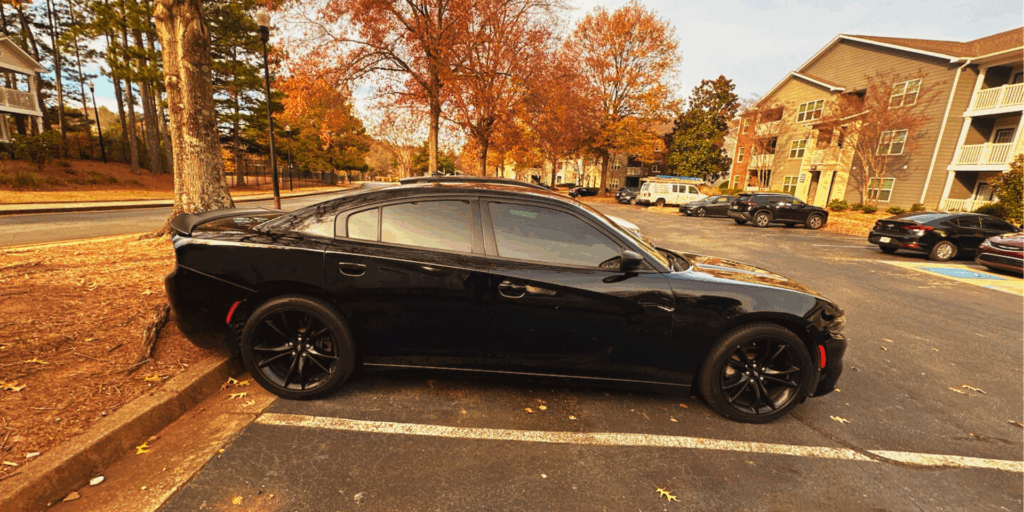
How Much Does It Cost to Ship a Car from Atlanta, GA to San Francisco, CA?
Cross-country shipping from Atlanta to the San Francisco Bay Area typically runs between $1,000 and $1,200. Distance is the primary factor. At 2,480 miles the per-mile rate drops significantly compared to shorter routes.
The $1,098 price for this Challenger worked out to roughly $0.45 per mile. This falls within the normal range for coast-to-coast transport. Standard sedans on the same route often cost about the same. The Challenger SXT weighs around 3,800 pounds. This weight stays under most carrier capacity limits.
Open transport costs less than enclosed shipping. The difference runs about 40% on average. For this route enclosed transport would have added another $400 to $500 to the total. Most customers shipping standard vehicles choose open carriers. The savings make sense for daily drivers and vehicles without special value.
Popular Routes: I-40 vs. I-10 Corridor for Cross-Country Shipping
Carriers heading from Atlanta to California have two main options. The I-40 corridor runs through Tennessee and Arkansas before crossing into New Mexico. The I-10 corridor drops south through Alabama and Louisiana into Texas.
Most drivers prefer the I-40 route during winter months. This path avoids Gulf Coast weather patterns. Snow in the Rockies can slow things down between November and March. The southern I-10 route stays warmer but faces hurricane season risks from June through November.

Our carrier took the I-40 corridor for this Challenger shipment. The route went through Memphis and Oklahoma City. From there the driver continued through Albuquerque and Flagstaff before entering California. Total driving time came to about six days under federal hours of service regulations.
Drivers can legally operate for 11 hours per day. They must rest for 10 consecutive hours afterward. Most carriers cover roughly 450 miles daily when accounting for fuel stops and vehicle checks.
See Also: Georgia To California Auto Transport
What’s Included in a $1,000-$1,200 Car Shipping Quote for 2,480 Miles?
The $1,098 price covered door-to-door service on both ends. A carrier picked up the Challenger in Atlanta at the customer’s residence. The delivery happened at the new owner’s address in San Leandro.
All quotes include basic cargo insurance. Carriers typically maintain $100,000 coverage per vehicle on their trailers. This insurance covers damage during transport. Customers can purchase additional coverage if their vehicle exceeds this value.
The quote includes loading and securing the vehicle. Carriers use four-point tie-down systems with heavy-duty straps. These connect to the chassis at reinforced points. The straps prevent movement during transit.
No hidden fees appeared on this shipment. Some brokers advertise low prices and then add charges later. We provide guaranteed quotes upfront. The customer pays the agreed price when the driver delivers the vehicle.
2018 Dodge Challenger Transport: Special Considerations
The 2018 Challenger SXT presents few complications for transport. Ground clearance measures about 5 inches. This height works fine with standard loading ramps. Lower trim Challengers with sport suspension might need extra attention.
The vehicle weighs 3,847 pounds ready to drive. Carriers can fit two Challengers on a standard nine-car hauler. The width measures 75 inches. This fits comfortably within carrier deck dimensions.
Challengers have functional parking brakes and can roll freely in neutral. Drivers simply release the brake and shift to neutral for loading. The process takes about 15 minutes per vehicle. No special equipment was needed for this particular car.
The customer prepared the car properly before pickup. They washed it and documented the existing condition with photos. Personal items came out of the interior. The gas tank sat at one-quarter full per carrier requirements.
See Also:
- Houston to Atlanta Car Shipping | Expert Relocation Transport
- Smooth Transport of a 2021 Mercedes-Benz E-Class
How Does Open Multi-Car Trailer Work: The Transport Process
Open multi-car trailers usually contain seven to nine cars. These carriers consist of two levels. The first level holds three to four cars. The next holds four to five cars depending on their size.

Carriers load the top deck first through hydraulic ramps. The rear portion of the top deck can be lowered to ground level. It forms a ramp with a gradient of 12° in the upward direction. Cars can either drive up this ramp on their own or be winched if they can’t move on their own.
After that, the hydraulics raise the top deck back into place. The driver will then load the cars into the lower-level deck. The lower-level deck is set at ground level. The vehicles merely drive right into the lower-level deck from behind the trailer.
The Challenger remained on the lower deck during this delivery. Having the unit on the lower deck makes it easily accessible for the loading and unloading processes. It also shields the unit from the sunlight during the cross-country drive.
Carriers hold all vehicles in place using four straps. These straps are connected from the front. There are also straps connected from the backs. These straps are hooked on specific points on the chassis or frames. This avoids movement when the vehicles are being transported.
The transport took eight days from pickup to delivery. A day was spent planning the pickup, while six days were spent behind the wheel. The last day addressed delivery planning for the Bay Area in the vicinity of San Francisco.
Cross-country travel can be quite frustrating, though the end result is well worth the effort. In fact, the $1,098 fare was substantially cheaper than what it would have taken to drive the Challenger 2,465 miles. Fuel costs alone would have been above $300.
Shipping Summary
Vehicle: 2018 Dodge Challenger SXT
Route: Atlanta, GA to San Leandro, CA (2,480 miles)
Atlanta, GA → I-20 W → I-22 W → I-40 W → I-44 W → I-80 W → San Leandro, CA
Service: Open Trailer | Multi-Car Hauler
Price: $1098 ($0.44 per mile)
Ferrari F12 Cross Country Shipping: Riviera Beach, FL to Fontana, CA
We just shipped a black 2014 Ferrari F12 from Florida to California. The transporting mileage from Riviera Beach, FL 33404, to Fontana, CA 92335, is 2,619 miles. The Ferrari was shipped in an enclosed trailer from December 11th to December 20th, a total of nine days. The cost to ship this private transport was $1,623.
This coast-to-coast relocation demonstrated the differences between shipping an exotic car and a normal car. The F12 required unique loading because of its low profile and its value. The price of $0.62 per mile was normal for a coast-to-coast relocation. The owner opted for enclosed shipping in order for his Ferrari to arrive in its original condition across the country.
Dealer To Dealer Car Shipping: Auto Transport Services
Tempus Logix provides pickup services for auctions and trade moves for dealers on a daily basis.
Dealers require rapid turnaround to avoid storage charges at the auction site. Each day that the car remains at the auction site results in higher storage charges.
We also cater to bulk orders for the dealership involving the movement of several cars simultaneously. Volume discounts apply to repeat customers. The dealer trade service enables the two dealerships to efficiently exchange their cars. We handle all the coordination between the two sites to ensure the smooth flow of inventory. We also handle the paperwork and scheduling of the dealers, allowing them to concentrate on the sales department. Many of the dealerships use our services on a weekly basis.
- Read about our dealer auto transport services.
What Makes Ferrari F12 Shipping Different From Standard Vehicle Transport
The Ferrari F12 rests on its chassis about 4 inches from the ground at the front of the vehicle. The usual loading ramps provide an angle of 14 to 18 degrees. This extreme angle leads to damage to the front splitter on lowered cars. Replacing the carbon fiber front splitter would cost several thousand dollars.
The transportation of a Ferrari requires special equipment. There are carriers who use race ramps to load and offload at a certain angle. The best way to load a car is to use a rollback truck with a hydraulic tilt. That way, the surface on which the car will be loaded is close to flat. The carriers use soft straps to hold an F12 in place. Loading an exotic car will take about one hour.
Cross-Country Routes: Southern vs Northern Corridor For CA-Bound Vehicles
Florida to California shipping offers two main routes. The southern I-10 corridor runs through Louisiana and Texas. This path stays warm year-round and avoids mountain weather. Major cities along this route include New Orleans and San Antonio.
The northern I-40 corridor crosses through Tennessee and Oklahoma into Flagstaff. Winter weather slows this route between November and March. Our Ferrari took the I-10 corridor through Houston and El Paso. Drivers cover about 450 miles daily under federal hour limits. The southern route adds about 100 miles compared to I-40 but saves time by avoiding weather delays. Carriers prefer I-10 from November through February for California-bound shipments.

Enclosed vs Open Transport: When Saving Money Isn’t Worth The Risk
Open transport costs 40% less than enclosed shipping. For a $30,000 sedan this matters. For a Ferrari F12 worth over $200,000 the savings are meaningless. Road debris or weather damage risk is too high. A single paint chip repair can cost $500 or more.
Hard-sided enclosed trailers have aluminum or steel walls. They haul just two to four vehicles. This spacing prevents contact during transport. Enclosed protection blocks road debris and weather exposure that can chip paint or damage interiors. The reduced capacity means enclosed trailers cost more to operate per mile. Carriers charge premium rates because they haul fewer vehicles per trip. Most exotic car owners consider this cost essential protection rather than an optional upgrade.
Exotic Car Transport Insurance And Protection
It is essential that they hold liability insurance of at least $1 million. The carrier responsible for shipping the exotic car usually has $2 million to $5 million in coverage. Always check insurance coverage prior to booking. Request a document that proves the insurance coverage is equivalent to the value of your car. Some carriers provide declared value coverage in excess of standard policies.
It only covers liability on the carrier. It does not cover pre-existing damage. Photos were taken prior to loading to show the condition of the vehicle. The driver and customer sign the Bill of Lading noting any problems. Photos include views of all angles of the vehicle and the odometer reading. The pictures will be crucial in case of damage. The carrier views the vehicles thoroughly prior to pickup
What To Do If Your Exotic Car Is Damaged While In Transit
Document damage at the time of the delivery. Record all problems on the Bill of Lading before signing it. Take your photos of the damage from various angles. Take close-ups of any scratches or dings. Have the driver acknowledge the damage on the form used for delivering your goods. Claims are filed within nine days from receipt of shipment. Photos are submitted, as well as a signed Bill of Lading copy. The insurance adjuster from the carrier investigates every claim that comes in.
Tempus Logix chooses to work with its insurance standards-compliant carriers only. There are stipulations in our carrier contracts regarding the carrier’s obligation to customers during transport. Tempus Logix helps its customers with the filing process, working with the carrier to resolve any problems that arise efficiently, with most valid damage claims being resolved within thirty days from receipt of claim.
Shipping Summary
Vehicle: 2014 Ferrari F12
Route: Riviera Beach, FL to Fontana, CA (2,618 miles)
Riviera Beach, FL → I-95 N → I-10 W → Fontana, CA
Service: Enclosed Trailer
Price: $1,623 ($$0.62 per mile)
How We Shipped a Mercedes 450SL Classic Car from Brooklyn to Spartanburg
This one will catch your attention.
And if you have even a shred of knowledge regarding the 450SL, you’ll understand that we weren’t referring to some ordinary car.
The car in question was a 50-year-old roadster from Germany that had probably seen more days in a garage with a cover on it than it had seen actual road time.
How The Transport Went
We reserved it on January 3rd. The first available date we set for January 5th. Rather a small window of time, yes? But we thought we could swing by.
This is where it got interesting.
But we didn’t select a carrier until January 7th. Usually, a wait like that would concern us. However, you’ve got to wait for the right guy sometimes. Not every carrier understands how to treat a classic Mercedes, you understand? They want someone who can understand that they’re dealing with a classic Mercedes, not a beat-up Honda Civic that they’re delivering to a junkyard.
After we identified that it was a match, everything happened quite quickly.
We picked the 1973 Mercedes-Benz 450SL up on January 7th, the same day we assigned the carrier. The driver got to Brooklyn, loaded it up carefully, and set off south.
January 8th. The next day. Brooklyn to Spartanburg in under 24 hours.
The Price
$986 to transport the classic car over the distance from New York to South Carolina. Sounds reasonable, doesn’t it?
Why this seems like the only normal price?
First, this is no ordinary cargo. It is certainly precious car, something that can’t be replaced. You sure as heck don’t want to throw this in with the common carriers on the truck with the SUVs and pray that all is well. Sure, you could do that technically, but you don’t want potential problems if you drive a 1973 450SL.
Second, the distance is a consideration. About 700 miles from Brooklyn to Spartanburg, which is not a minute drive, but not a dash across town, either.
Thirdly, you are actually getting expertise. The driver who was hired to get the job done knew the ropes. No scuffs, no fanfare, simply good, clean handling all the way.
Side Note: Key takeaway from Mercedes’ 450
You’re not a Mercedes buff? Then the 450SL is the car people hold on to. They produced the thing from 1971 to 1980. It was a tank with a roadster and a removable top and V8 power. Real old-school German building, when a guy could actually work on his own car.
The problem is that they’re getting harder to find every year, so if you’ve got one that’s in good nick, you don’t want some Minger driving it to bits. This is exactly why this customer made such a great decision. They held off till a good airline came along, and that waiting period of two days must have saved them many headaches.
The Route
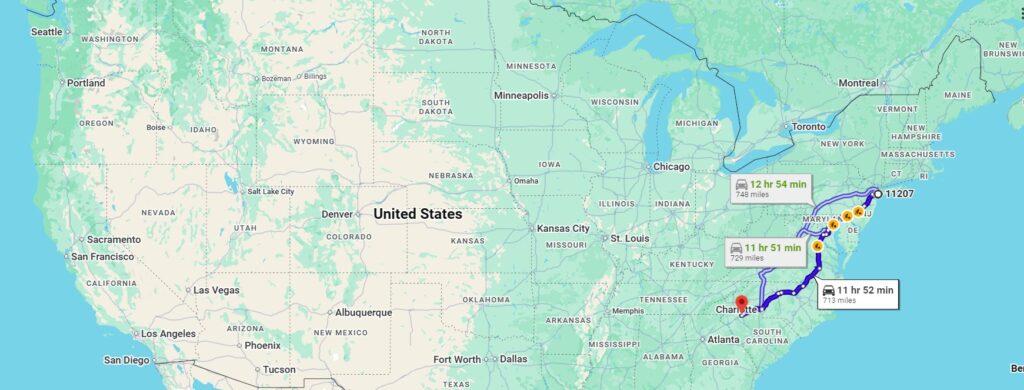
Hauling a classic Mercedes from Brooklyn down to Spartanburg wasn’t a mystery, but it wasn’t a breeze either. Most fellows take I-95 South out of New York, squeeze through Jersey and Maryland, then hop over to I-85 around Virginia, and from there it’s a straight run into South Carolina. Spartanburg sits upstate, close to Greenville if you know the lay of the land.
And the road? Early January traffic was agreeable: no rush to the beach, no summer peak, just open highway and truckers hustling to make up a little time after the holidays.
What Surprised Us
Snow, icy roads, and freezing temperatures can cause delays if not handled properly. That’s why our team carefully plans winter routes, works only with experienced carriers, and monitors weather conditions in real time to keep your shipment safe and on schedule. But sometimes, with the right truck driver, all the stars aligning, it all comes together. The customer’s 450SL arrived in Spartanburg in under 48 hours after it was picked up in Brooklyn by the carrier. That’s not common. It is the type of fast and consistent service people call for when they need another car hauled.
If You’re Shipping a Classic
Choose the right partner for the pickup. A seasoned one who understands picking up classic cars, who won’t tighten things up too much that the undercarriage will suffer, who actually believes what he is carrying. This took two extra days, but we got the right carrier for the job. It came spotless. It is all worth the wait.
Transport Summary
- Vehicle: 1973 Mercedes-Benz 450SL
- Origin: Brooklyn, NY 11207
- Destination: Spartanburg, SC 29301
- Distance: ~700 miles
- Price: $986 ($0.70 per miles)
- Total Transport Time: 1 day
- Route: I-95 South through New Jersey and Maryland, then I-85 into South Carolina
See also: South Carolina to New Jersey Car Shipping
Maryland to South Carolina Car Shipping
1986 Corvette Classic Car Shipped from Concord, NC to Canton, OH
We just finished a transport that went exactly as it was supposed to. It was a 1986 Chevrolet Corvette from Concord, North Carolina to Canton, Ohio. From the time the transport was booked until the time the car was delivered: three days. Believe , this kind of turnaround time makes all of us, as well as the customer, happy.
The Timeline
The customer was booked on the 4th of January. We had them on the schedule for a pickup from the 5th of January. That was their first available time. The same day, they were assigned to a carrier. The driver arrived on the 6th for the pickup, and the Corvette was delivered on the 7th.
That is quick. Not all transport moves that quickly, but if you have a route like from North Carolina to Ohio and you have a driver who is already headed that way, it all comes together.
Concord to Canton
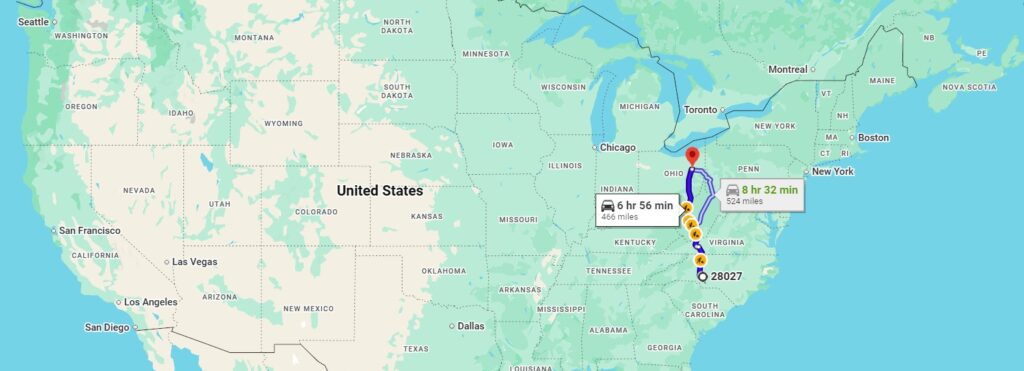
Concord is right outside Charlotte, so we’re talking easy access right off the bat. Canton is 466 miles north of us. That’d be up through the Appalachian Mountains on I-77 and into Ohio. Piece of cake. No running through country roads to get there.
See also: Florida to Ohio Car Shipping: Snowbird’s Guide & Costs
The vehicle operator that we hired had an open trailer setup to transport three cars. A pretty usual scenario when it comes to deliveries involving multiple vehicles that travel in the same direction. Open trailer configurations represent the industry norm, especially used effectively during long-distance relocations that don’t involve harsh weather conditions.
Loading a Classic Corvette the Right Way
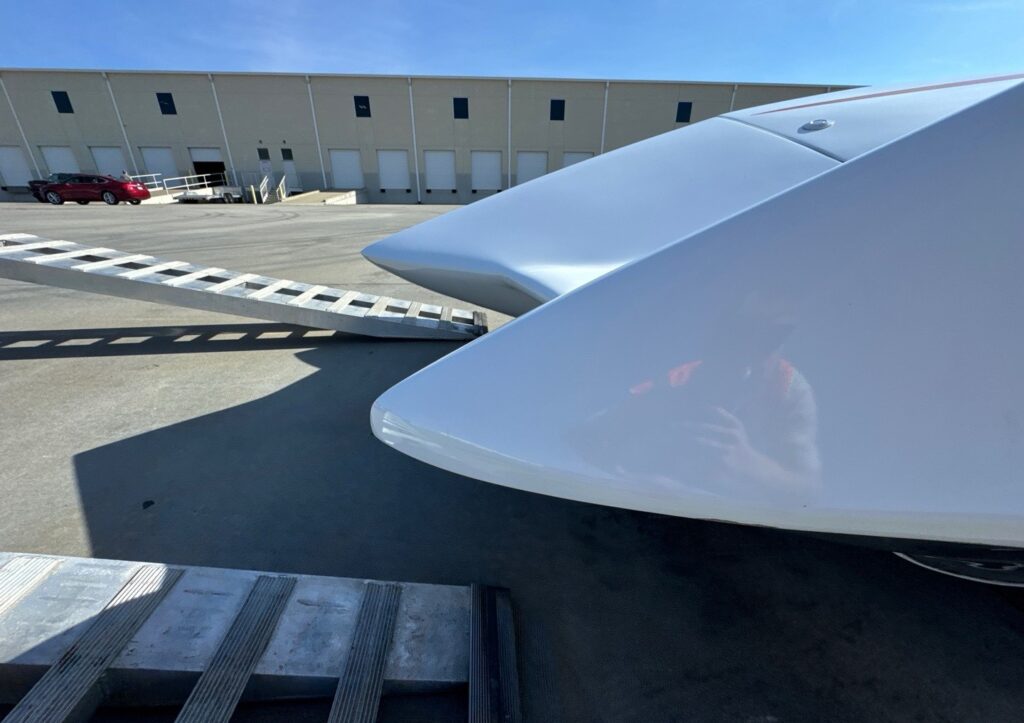
Here’s something most people overlook: an ’86 Corvette sits really low to the ground. Very low. If you don’t know how to use ramps properly, you’ll end up scratching the front bumper or undercarriage before the car is even on the trailer.
Our driver came prepared. He used low-angle ramps made for sports cars and took his time getting everything lined up. No rushing, no scraping. Once the Corvette was on the trailer, he strapped it down at all four corners with the right tie-downs, making sure nothing stressed the suspension or body.
Too many people rush this step; you simply cannot. A classic like this deserves the extra five minutes to do it right.
The Part That Made This One Stand Out

That kind of professionalism matters. Especially when you’re trusting someone with a car that means something to you.
Why This One Went So Smoothly
A couple of things came together in this instance that I’d like to point out.
First, the client scheduled us when we already had drivers lined up to make this run, so it was easy to simply assign a carrier. And it wasn’t summer, so it was no problem to book.
Second, it was a direct shot, no weird turns and no additional pickups to pick up along the way. This was just a straight shot.
Third, and what is really important, is that we were able to assign a carrier to this client who has experience hauling classic cars. Not every carrier does. There are carriers who are accustomed to hauling newer autos and pickup trucks every day, but a low-slung sports car from the ’80s calls for something a little different.
What you should know if you are shipping a classic car
Communication is key. From the time you reserve until the time the driver is assigned, the time they expect to pick up from you, and the estimated time of delivery. If this isn’t being communicated to you, something isn’t right.
The driver should be equipped: Proper ramps and straps to ensure your car is loaded safely. In case they are unable to offer that, don’t let them rush. A good transport company must be flexible. But flexibility is only as important as professionalism. Things happen in life. Banks have to be spaced. There is traffic delay. A good transport company accommodates without forgetting that you exist.
Transport Summary
Vehicle: 1986 Chevrolet Corvette
Route: Concord, NC to Canton, OH
Distance: 466 miles (Southeast to Midwest corridor)
Primary Routes: I-77 N through Appalachian Mountains into Ohio
Service: Open-air multi-car carrier (3-car trailer)
Cost: $433.00 ($0.93 per mile)
Transit Time: 3 days (January 4 booking – January 7 delivery)
Season: Winter
Shipping Chrysler 200 from Merrick, NY to Chapin, SC Delivered in 4 Days
So here are the facts about relocating a car on December 22nd. What people love to think is that the week between Christmas and New Year’s is a dead period. Nothing is moving, everything is closed, right? Wrong.
One of our customers at Merrick called up right around the holidays with their sights fixed on getting their shiny new 2025 Chrysler 200 to South Carolina. Now, to be truthful with you, we weren’t sure if we could deliver it that quickly with the upcoming holiday. But what actually went down is what follows.
How It Went Down
We fixed the reservation for Dec 22 and set Jan 3 as the first available pickup time. Let everyone have a couple days to clear the holiday fog and get back to the real world, okay?
The part of us that was surprised was how easily things were falling in place. On the same day, January 3rd, a carrier was allocated to us. They collected the Chrysler from Merrick that afternoon. No hanging about. No “we will get there sometime next week” attitude.
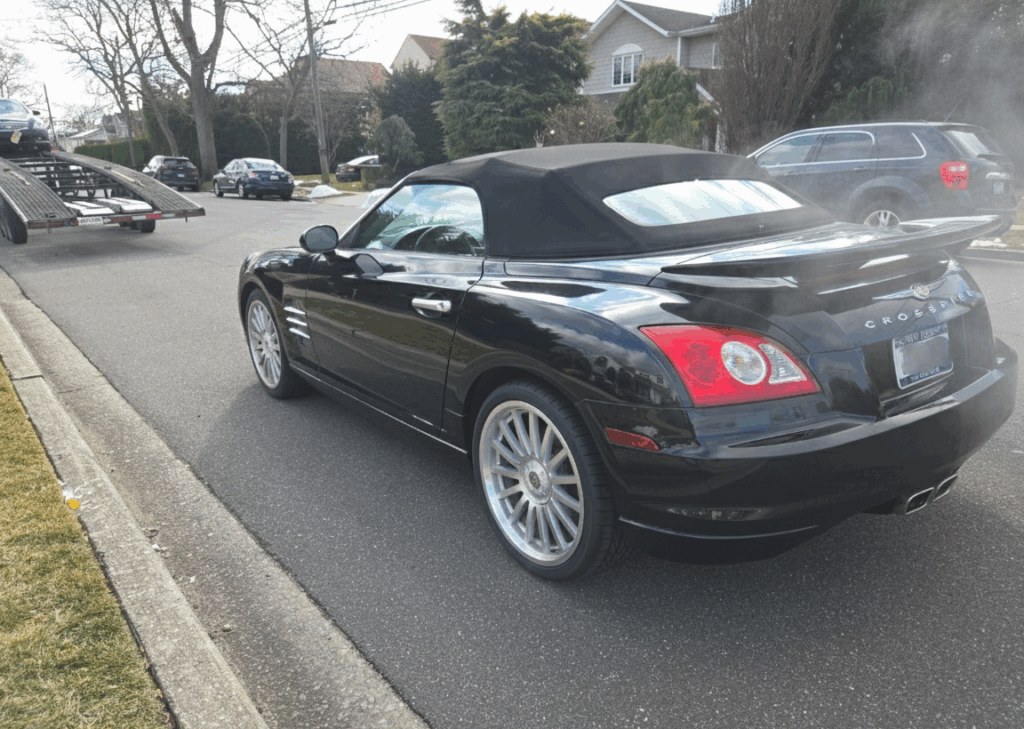
The drive from Long Island to Chapin, though, isn’t bad. That’s 750 miles, and you take I-95 through Jersey, Maryland, and into the Carolinas. Can do it in a solid day and a half, taking breaks. Delivered on the 7th. Four days from door to door. This is even during a busy shipping season.
Why This Timing Actually Worked
Usually, most people believe January is just dragging because December was crazy. The truth is, most carriers will begin traveling for this new year because they have to make up for what they missed in December. They’re eager and ready to go.
If you position yourself correctly following the holiday rush, you’ll find drivers looking for work, and it’ll be no contest, no hanging around. For this particular pickup, he continues, it’ll be $799 for a brand-new Chrysler 200, NY to South Carolina. That’s a good rate for the mileage. It’s a 2025 model, and they were obvious about it being a car to handle with kid gloves. Not some clunker to slop into the back of the truck and forget about.
The Route
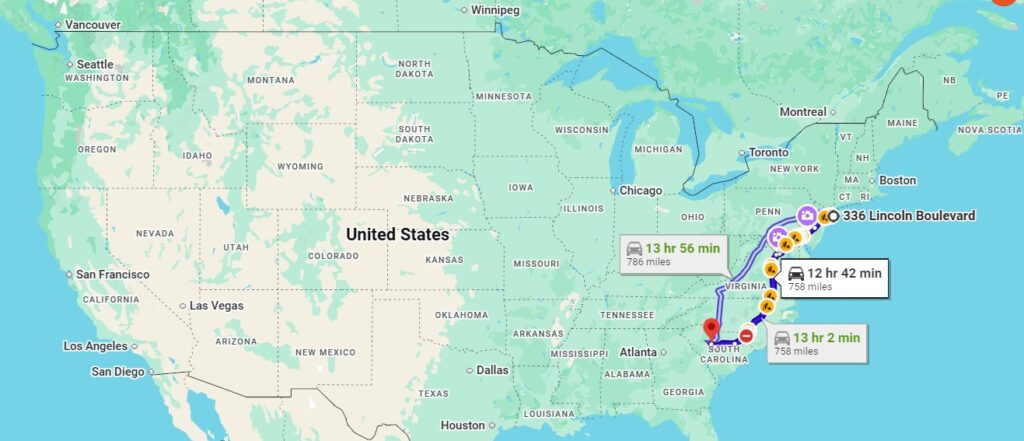
Merrick to Chapin isn’t a regular route, but we know the area. It’s from the suburbs of Long Island to the lakes of South Carolina. Chapin just so happens to be on Lake Murray. Good place to go if you haven’t been. Most people take 95 South, come around through North Carolina via 85, then down into South Carolina. Real easy, no going through the mountains, no wacky route changes. Only way you’ll get held up is around DC or Richmond. But come early January, the roads will be wide open. Everybody’s at their job, everybody else is back in their bed. In fact, this is one of the easiest times to relocate a car to the East Coast.
Transport Summary
Vehicle: 2025 Chrysler 200
Route: Merrick, NY to Chapin, SC
Distance: 758 miles (Northeast to Southeast corridor)
Primary Routes: I-95 S through Mid-Atlantic states, I-85 into South Carolina
Service: Open-air multi-car carrier
Cost: $799.00 ($0.94 per mile)
Transit Time: 4 days (December 22 booking – January 3 pickup – January 7 delivery)
See also: New York to North Carolina Car Shipping
Auto Shows Throughout the US
From the beginning of time, rituals and rites attracted the masses. They had many meanings and purposes of social significance. As time went by, the ceremony diverged from sacred importance to entertainment, and yet it kept the original intent of aiding societal dynamics. Nearly every industry has its devotees, and the automotive industry is no exception. Auto shows are public exhibitions visited by vehicle lovers interested in seeing the newest automotive advancements and fancy vintage classics. Motorheads and car nuts enthralled by the tradition of attending auto shows several times a year can get into zealous conversations. Moreover, people of all ages and genders, including those indifferent to automobiles, will always find a reason to frequent such exciting events. After all, cars play an indispensable role in virtually any modern household.
The First Car Show
In 1900, Madison Square Garden in New York City hosted the inaugural automotive display in the United States. The so-called Horseless Horse Show lasted seven days, featuring 31 cutting-edge rides and a selection of accessories, all owned by 66 participants. One of them was Ransom Eli Olds, the man who built the first-ever operational automotive assembly line and the manufacturer of the Curved Dash, the very first mass-produced car. Visiting such a progressive event has cost 50 cents a ticket, which is roughly 14 dollars in 2021 currency. Despite the exorbitant fees, more than 10,000 people attended the exciting event.
Activities in Auto Shows
Nowadays, there is much more to a car show than simply marveling at the newly invented machinery. You can sit in a great variety of vehicles in every price range, designed by leading companies. Brand experts will tell you about the latest innovations and answer questions regarding the prices and characteristics of their products, which are sometimes available for purchase straight from the exhibition. Another feature that, by the way, is yet impossible online is taking a test drive. Many manufacturers offer a wide range of vehicles for test-driving. The process is usually quite simple, requiring no additional paperwork other than a driver’s license. Those who don’t have one, like our youngsters, won’t be left behind either! Thanks to modern technology, they can feel the joy of using full-size driver simulators surrounded by giant screens, providing a truly immersive experience. All that helps you make a wise decision on purchasing a new ride or get a better idea of the automotive industry.
The Most Popular Auto Shows
The number of different auto shows throughout the nation is overwhelming. To name a few that are the most fascinating. The Chicago Auto Show, running since 1901, is the largest in the United States. It typically occurs in mid-January at McCormick Place, a convention center on the Near South Side of Chicago covering 1.2 million square feet. Next is the North American International Auto Show (or the Detroit Auto Show). Can you imagine? This one has been held every year since 1907, excluding ten years during World War II, when manufacturers concentrated more on making vehicles for the military. Finally, the San Francisco International Auto Show, known to be the largest one in North Carolina and the second largest in the Western US, in 1958, was used as a protest against banning foreign car dealers from participating in local North American motor shows. After some rebel enthusiasts came together, the Import Car Show was created and renamed in 1982. It seems clear enough how amusing car shows are. Technically, you could visit one every month or so, being able to live in a world full of extraordinary vehicles. So if the goal is to purchase a car or become an exhibitor, contacting Tempus Logix to ship your motor vehicle(s) would be a wise decision. We will help with auto transportation in no time to virtually any spot in the US.
Guaranteed Pickup Service: Trust & Reliability
A person has to move his car. He searches on the Internet, gets a quote, and everything is fine. The cost is decent. The company guarantees to “find a driver quickly.” Both parties are satisfied.
And then three days go by. No driver. Four days. Nothing yet. Now they are all calling every morning asking for an update, and the broker keeps repeating, “We are working on it.”
That’s the point when people realize they should have listened to the pickup guarantee portion. In the car transportation business, a guaranteed pickup means the company will have a driver assigned and your car will be picked up by a specific date. Not “we’ll try our best” or “it usually happens quickly.” A real commitment with your dates honored.
The Part Nobody Tells You
For most car transporters, is working like the “open board” method. Your car goes on a list, and when drivers have that route as part of their journey, they scoop it up. It gets the job done. eventually. There’s absolutely no rush. For example, if your pickup location is the popular route from California to Texas, fantastic. Everyone loves that route. However, when shipping your car from Billings, Montana, or Portland, Maine, during the month of February? Not so much.
Dealing with drivers long enough to know that they are running a business. They take the freight that works their route well and pays good money. Your car is competing against dozens of other vehicles. A guaranteed pickup turns that on its head. The company has to make it happen. Whether that means paying a driver more money or doing favors is irrelevant. Your car is not sitting around waiting for someone to pick it up.
What “Guaranteed” Really Means
Guaranties aren’t all the same, and that’s where the rub is. Some shops will come dig out your car, but their timeframe still is ‘7 to 10 days.’ So, your car gets picked up quickly, and it’s just sitting in a truck stop somewhere, stopping all over the country, for a week and a half. That’s not what most people have in mind.
Others give you the dates for pickup and delivery. Now we are talking. But you will have to expect a hefty increase, anywhere from 30 percent to 50 percent above the basic rates. It’s like you are paying for the premium delivery service.
But then there’s also “fine print.” It seems as though guarantees come with some sort of “catch.” Weather-related delays are not guaranteed. If you’re not there to be picked up? The guarantee is void. If the driver breaks down? They fulfilled their obligation. You should read the fine print. If a company can opt out of a guarantee on six different grounds, then the company is not offering a very good guarantee.
This is where experience matters. Tempus Logix has extensive nationwide transport experience and guarantees pickup, so you’re not stuck with a soft ‘7-10 days’ window dressed up as a promise.
The Routes That Actually Need It
Pretty much every trucker has put it this way: “If it’s a highly traveled route, there’s no need for a guarantee. From LA to Phoenix? That truck’s going whether it rains or shines. From Florida to New York? Lots of trucks haul that route every week of the year.”
But when you look at shipping from, for instance, the East:
1. Rural and sparsely populated regions
2. Winter in the Northern states: Car drivers avoid the snowfall.
3. Small towns not directly on the major highways
4. Anywhere to Alaska (that’s a whole different game) These routes are logical in regard to guaranteed pick-up. Otherwise, one could be waiting for several weeks for a transport partner with a willingness to detour. Honestly, I was surprised at this when I entered the industry. I thought every route was pretty much the same. Not true. Geography and timing vary way more than I thought they would.
When Regular Service Is Fine
If you have the time, save your money.
Booked three weeks in advance? Spring or fall, when the weather’s good? Shipping between major cities? You don’t need the guarantee, probably. It should take a good broker no more than 2 to 5 business days to find you a driver.
People pay extra for the “assured service delivery” feature, and they only had a full calendar month before they even had a use for the vehicle. Total waste. You can think of a dozen ways you could’ve used the cash, upgrading your insurance policies, for example, or using an enclosed transport service if the item being shipped held particular value. It is guaranteed for tight schedules and hard routes. That is all.
The Frustrating Part
Here’s where people lose money. They pay for regular maintenance. Then they’re like, ‘Oh my god, it’s day five and we don’t have a driver,’ and they want to upgrade to guaranteed. Well, it’s last-minute notice. The price is going to be even higher or, worse yet, the company won’t be able to meet it. If you think that perhaps you’ll be needing the guarantee, buy one in advance. This is far less expensive than the price of upgrading in a panic. Not to mention: last minute expedited shipping or, at worst, starting from scratch.
Questions Worth Asking
Then, before actually paying for the “guaranteed pick up,” ask these questions:
1.”What exactly are you guaranteeing, just pickup, or delivery too?”
2.“What voids the guarantee?”
3. “What happens if you miss the date?”
4. “That last one matters,” one expert said. “Some will refund the guarantee fee,” while others will refund “a portion of the cost.” A handful “won’t do a thing and just apologize.” It pays to know beforehand.
Usually, the reputable companies will make it right when they really drop the ball. But what constitutes making it right varies from person to person. You have to get the details.
Summary
A guaranteed pickup is an insurance policy for your schedule. It’s an insurance policy for your schedule, not an insurance policy for your vehicle, which would be a completely separate thing. It’s an insurance policy for knowing that logistics will occur.
If you have the flexibility in your scheduling, blow this off. If you have a tight schedule on your hands, this may be worth the investment. Just be sure you understand what you’re actually getting for your money, as “guaranteed” is a price point that has many variations.
And to be frank, just the peace of mind alone, that’s worth it. It’s got to be nice to not have to spend a week waiting to hear about a driver update via your phone. Nonetheless, that’s the way it is. Not a complex thing to understand, but something most people don’t consider until they’re in the thick of needing to transport a car yesterday.






